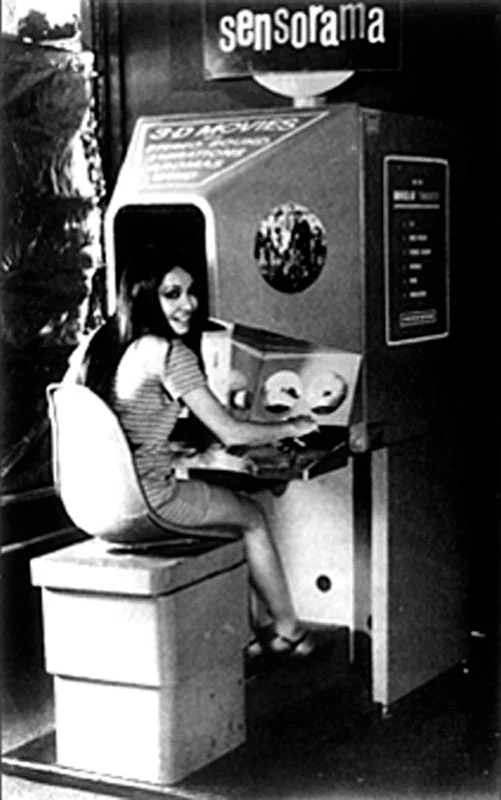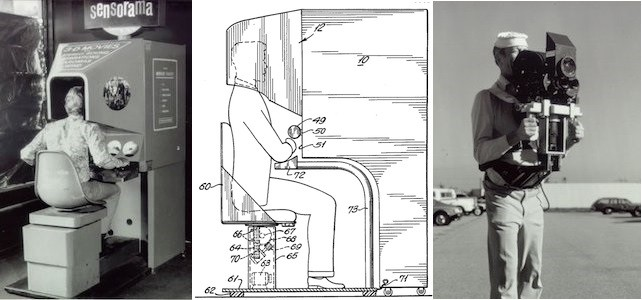created 2025-05-09, & modified, =this.modified
rel: Sensorama Simulator Real World As Maximum Art-Emotional Value

A device made by Morton Heilig, considered to be one of the earliest representations of a virtual reality system. It was the start of what he called “Experience Theater” and was covered in his paper “The Cinema of the Future”.
It had fans, a color display, odor emitters, stereo-sound and a motional chair.
Another unique feature of the machine is that it completely isolates the spectator from the surrounding environment. No matter how noisy the area about the machine (telephones, typewriters, crowds, traffic, etc. ) it in no way detracts from the purity of the spectator’s experience.
The Cinema of the Future Paper
Paper starts with discussion of the pandemonium in the film industry, of each studio developing a revolutionary system and the spectacle of the experience.
These systems are still stunted, and limit the actual artistic engagement.
Mankind created three forms:
- Science to bestow maximum knowledge on humanity
- Art to digest the knowledge into a deeper realm of feeling, generating emotions of beauty and love that guide actions
- Industry to act upon the material world, so as to produce more living energy for mankind
In his estimation Art is the furthest from its goal. It struggles to achieve this.
When a primitive man desired to convey to another man the complete emotional texture of an experience that occurred to him he tried to reproduce, as closely as possible, the elements that generated his own emotions. His art was very simple, being limited to the means provided by his own body
The laws of artistic methodology must be:
“The nature of man’s art is fundamentally rooted in his peculiar psychic apparatus and is limited by the material means at his disposal.”
“Consciousness is a composite of all the sense impressions conveyed to the brain by the sensory part of the nervous system which can be divided into the great receiving organs-the eyes, ears, nose, mouth, and skin.”
Open your eyes, listen, smell, and feel-sense the world in all in magnificent colors, depth, sounds, odors, and texture – this is the cinema of the future!
Thought
The he envisions takes up 100% of the visual field, compared to small amount provided from cinema screens.
This is something very curious. The dark of a cinema, and how we can or cannot shut out the other humans to immerse ourselves. To what degree is the cinema public? How drastically can the shadowy presence of others throw you off?
I’ve never had a tremendously large television to watch my films on (besides moments where I projected as part of a party). It tends to be just me watching. I almost cannot see this changing easily, because my habits of watching are so focused. I know I deprive myself here since my screen is so small (I favor small laptops) but also relatively I’m able to get a full screen experience because I am so focused on the smaller screen, close to my face, often in the dark.
I’ve been in home theaters where the screen is massive, but there’s so much visual noise surrounding it, and you are so pushed back, that it might as well be an ipad held at arm length.
Yes, the cinema of the future will far surpass the “Feelies” of Aldous Huxley’s Brave New World
Complaints of Realism in Film
People already complain about the excess of realism in films and say the new inventions shall plunge us from bad to worse. Although the spirit of their complaint is valid, their use of the word “realism” is not. “Realism,” or, in aesthetic terms, “experience,” is that something which is created by the unity of the outer world with the inner. No matter how extensive the artist’s means, he must use them to provoke more of the spectator’s participation, not less. For without the active participation of the spectator there will be no transfer of consciousness, no art. Thus art is never “too” realistic]. When either too much or too little is given, there just isn’t any “realism.” Poor use of cinema’s remarkable new powers is no more of a case against them than daubing with oils is a case against painting.
He says that each sense monopolizes man’s attention in the following proportions.
Sight: 70%
Hearing: 20%
Smell: 5%
Touch: 4%
Taste: 1%
Thought
I can’t make sense of these values.
Another proposed Law:
“The brain of man shifts rapidly from element to element within each sense and from sense to sense in the approximate proportion of sight, 70%; hearing, 20%; smell, 5%; touch, 4%; and taste, 1%, selecting one impression at a time according to the needs of individual and racial development.”
If you give a viewer 5% of the screen (in a typical cinema), he must solve the problem of visual attention another way or lose his main aesthetic power.
Another proposed Law:
“In his creative process, man is imposed on by outer impressions. He learns the secrets of their basic principles through imitation and then subjects these to the needs ofhis own expression. He goes from reception to imitation to creation, i.e., from portraying the outer to portraying the inner world.”
